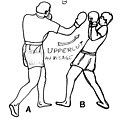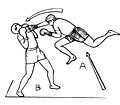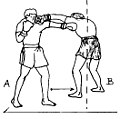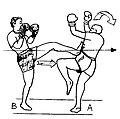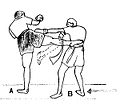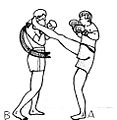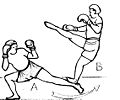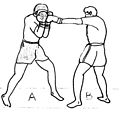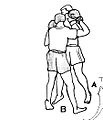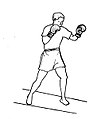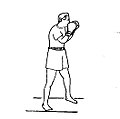Kickboxing
This article needs additional citations for verification. (May 2008) |
This article contains instructions, advice, or how-to content. (January 2009) |
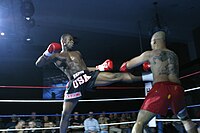 | |
| Focus | Striking |
|---|---|
| Country of origin | |
| Creator | Osamu Noguchi Tatsuo Yamada |
| Famous practitioners | Tim Sylvia, Anderson Silva, Rashad Evans, Sam Stout, Benny Urquidez (USA), Dennis Alexio (USA), Maurice Smith (USA), Stan Longinidis (Greece/Australia), Toshio Fujiwara (Japan), Fred Royers (NL), Rob Kaman (NL), Pete Cunningham (CAN), Mike Zambidis (Greece) |
| Parenthood | Western Boxing, as well as Kicks derived from various Asian Martial Arts. |
Kickboxing (キックボクシング) refers to the sport of using martial-arts-style kicks and boxing-style punches to defeat an opponent in a similar way to that of standard boxing. Kickboxing is a standing sport and does not allow continuation of the fight once a combatant has reached the ground.
Kickboxing is often practiced for self-defense, general fitness, or as a full-contact sport. In the full-contact sport the male boxers are bare-chested wearing shorts and protective gear including: mouth-guard, hand-wraps, 10-oz. boxing gloves, groin-guard, shin-pads, kick-boots, and optional protective helmet (usually for those under 16). The female boxers will wear a tank top and chest protection in addition to the male clothing/protective gear. In European kickboxing, where kicks to the thigh are allowed using special low-kick rules, use of boxing shorts instead of long trousers is possible.
In addition, amateur rules often allow less experienced competitors to use light or semi-contact rules, where the intention is to score points by executing successful strikes past the opponent's guard, and use of force is regulated. The equipment for semi-contact is similar to full-contact matches, usually with addition of head gear. Competitors usually dress in a t-shirt for semi-contact matches, to separate them from the bare-chested full-contact participants.
Kickboxing is often confused with Muay Thai, also known as Thai Boxing. The two sports are similar, however, in Thai Boxing, kicks below the belt are allowed, as are strikes with knees and elbows.
There are many arts labelled kickboxing including Japanese kickboxing, American kickboxing, Indian, Burmese boxing, as well as French savate. The term kickboxing is disputed and has become more associated with the Japanese and American variants. Many of the other styles do not consider themselves to be 'kickboxing', although the public often uses the term generically to refer to all these martial arts.
The term kickboxing was created by the Japanese boxing promoter Osamu Noguchi for a variant of Muay Thai and Karate that he created in the 1950s. The term was later used by the American variant. When used by the practitioners of those two styles, it usually refers to those styles specifically.

By area
Japan

On December 20, 1959, a Muay Thai among Thai fighters was held at Tokyo Asakusa town hall in Japan.Tatsuo Yamada, who established "Nihon Kempo Karate-do", was interested in Muay Thai because he wanted to perform Karate matches with full-contact rules since practitioners are not allowed to hit each other directly in karate matches. At this time, it was unimaginable to hit each other in karate matches in Japan. He had already announced his plan which was named "The draft principles of project of establishment of a new sport and its industrialization" in November, 1959, and he proposed the tentative name of "Karate-boxing" for this new sport. It is still unknown whether Thai fighters were invited by Yamada, but it is clear that Yamada was the only karateka who was really interested in Muay Thai. Yamada invited a Thai fighter who was the champion of Muay Thai (and formerly his son Kan Yamada's sparring partner), and started studying Muay Thai. At this time, the Thai fighter was taken by Osamu Noguchi who was a promoter of boxing and was also interested in Muay Thai. The Thai fighter's photo was on the magazine "The Primer of Nihon Kempo Karate-do, the first number" which was published by Yamada.
There were "Karate vs. Muay Thai fights" February 12, 1963. The three karate fighters from Oyama dojo (Kyokushin later) went to the Lumpinee Boxing Stadium in Thailand, and fought against 3 Muay Thai fighters. The 3 karate fighters' names are Tadashi Nakamura, Kenji Kurosaki and Akio Fujihira (as known as Noboru Osawa). Japan won by 2-1 then. Noguchi studied Muay thai and developed a combined martial art which Noguchi named kick boxing. However, throwing and butting were allowed in the beginning to distinguish it from Muay Thai style. This was later repealed. The Kickboxing Association, the first kickboxing sanctioning body, was founded by Osamu Noguchi in 1966 soon after that. Then the first kickboxing event was held in Osaka, April 11, 1966.
Tatsu Yamada died in 1967, but his dojo changed its name to Suginami Gym, and kept sending kickboxers off to support kickboxing.
Kickboxing boomed and became popular in Japan as it began to be broadcast on TV. Tadashi Sawamura was an especially popular early kickboxer. However, the boom was suddenly finished and became unpopular after Sawamura was retired. Kickboxing had not been seen on TV until K-1 was founded in 1993.
In 1993, as Kazuyoshi Ishii (founder of Seidokan karate) produced K-1 under special kickboxing rules (No elbow and neck wrestling) in 1993, kickboxing became famous again.
The sport has spread through Europe, North America, Australia and New Zealand.
North America

The Count Dante, Ray Scarica and Maung Gyi are the real pioneers of American Kickboxing. Had tournaments back in 1962.
Between 1970 and 1973 (in federation PKA) a handful of kickboxing promotions were staged across the USA. In the early days the rules were never clear, one of the first tournaments had no weight divisions and all the competitors fought off until one was left. A very young Benny Urquidez reached the final. Unfortunately at world level there was no infrastructure, no set format of rules, the elements of danger were still included in the combat forms. As the martial arts disciplines grew in popularity mans urge to meet his/her peers on the competition floor demanded conformity, a universal rules system, and a method that would ensure the practitioners safety whilst competing at sporting level. Various groups came forward in an attempt to unite all these Eastern martial disciplines under one set of rules that would cover the many and various forms of combat all under one umbrella. After many many failures, petty squabbles and political in fighting an organization was formed and termed the World Kickboxing Association (WKA). The impetus of the WKA on world martial arts as a whole was revolutionary. They were the first organised body of martial arts on a global scale to sanction fights, create ranking systems, and institute a development programme. Whereby at grass roots level children of all ages under a strict code of ethics and safety could learn via satellite WKA clubs in every City, Town, and village, a martial arts discipline thus ensuring for future years the growth of the sport.
Today, the International Kickboxing Federation (IKF) is the most active kickboxing sanctioning body in North America and one of the top 3 worldwide organizations. The IKF also hosts the Largest All Amateur - Full Contact & Muay Thai - Kickboxing Tournament in the World, the IKF World Classic.
Europe, Australia, New Zealand and South America
Jan Plas, the Dutch kickboxer, founded Mejiro Gym with some Muay Thai pioneers in the Netherlands in 1978, after he learned kickboxing from Kenji Kurosaki in Japan. Plas also founded NKBB (The Dutch Kickboxing Association), which was the first kickboxing organization in Netherlands, in 1978. The sport took off in the U.S. with the popularity and success of Kev Kelsey in the 1970s. In South America the kickboxing was introduced by martial artist and kickboxing champion, Hector Echavarria, who brought the famous Joe Corley's Professional Karate Association, the International Sports Karate Association, and the United States Karate Association to Latin America.
Styles

Arts labelled as kickboxing include:[1]
- Adithada (Indian kickboxing) – A form of kickboxing that uses knee, elbow and forehead strikes.
- Lethwei (Burmese kickboxing) – Traditional Burmese martial arts of which has now grown into a popular kickboxing event with strong emphasis on knee, elbow strikes and headbutt. Any part of the body may be used to strike and be struck. It is also known as Bando kickboxing.
- Pradal Serey (Khmer "Cambodian" kickboxing) – Possible predecessor of Muay Thai with an emphasis on elbow techniques.
- Gwon-gyokdo (Korean kickboxing) that is a mix between Muay Thai and Tae Kwon Do. This art is also known as 'Kyuk Too Ki' in some parts of Korea.
- Muay Thai (Thai boxing) – Traditional Thai martial art of which has now grown into a popular kickboxing event with strong emphasis on knee and elbow strikes.
- Muay Boran (Ancient Boxing) – Predecessor of Muay Thai, allows the use of headbutts.
- Japanese kickboxing – Similar to Muay Thai, but different point system is taken. The first fighting style to adopt the name of "Kickboxing".
- American kickboxing – Not allowed to kick below the waist.
- Savate (French kickboxing) – Allows the use of shoes.
- Sanshou/Sanda (Chinese kickboxing) – The applicable component of wushu/kung fu of which takedowns and throws are legal in competition as well as all other sorts of striking (use of arms and legs).
- Shoot boxing – A Japanese form of kickboxing which allows throwing and submission while standing, similar to Sanshou.
- Yaw-Yan (Filipino kickboxing) – Sayaw ng Kamatayan (Dance of Death) is the proper name for Yaw-Yan, a Filipino martial art developed by Napoleon Fernandez. The art resembles Muay Thai in a sense, but differs in the hip torquing motion as well as downward-cutting of its kicks.
There are many additional derivatives of these forms, as well as combined styles which have been used in specific competitions (e.g. K-1).
In other combat sports
Kickboxing is popular in mixed martial arts and professional wrestling competition.
Rules
Japanese
These rules are almost same as Muay Thai rules:
- Similarities
- Time: three minutes × five rounds
- Allowed to attack with elbow
- Allowed to attack with knee
- Allowed to kick the lower half of the body except crotch
- Allowed to do neck-wrestling (folding opponent's head with arms and elbows to attack the opponent's body or head with knee-strikes)
- Head butts and throws were banned in 1966 for boxers' safety.
- Differences
- No ram muay before match
- No Thai music during the match
- Interval takes one minute only as same as boxing
- Point system:
- In Muay Thai, kicking to mid-body and head are scored highly generating a large number of points on judges' scorecards. Moreover, kicking is still judged highly even if the kick was blocked. In contrast, punching is worth fewer points. In kickboxing punches and kicks are held in closer esteem.
American
These are the rules used in American and Australian Full Contact Karate.
- Opponents are allowed to hit each other with fists and feet, striking above the hip
- Using elbows or knees is forbidden and the use of the shins is seldom allowed.
- Bouts are usually 3 to 12 rounds (lasting 2 - 3 minutes each) for amateur and professional contests with a 1-minute rest in between rounds.
This is in contrast to Muay Thai, where the use of elbows and knees are allowed. In fact, some Muay Thai practitioners consider kickboxing a "watered down" version of Muay Thai. Fighters and promoters can agree to various rules including kicks only above the waist, kicks anywhere, no knee strikes, knees only to the body, and so on. American Kickboxing is essentially much a mixture of Western Boxing and Karate.
The round durations and the number of rounds can vary depending on the stipulations agreed to before hand by each fighter or manager. A winner is declared during the bout if there is a submission (fighter quits or fighter's corner throws in the towel), knockout (KO), or referee stoppage (Technical Knock Out, or TKO). If all of the rounds expire with no knockout then the fight is scored by a team of 3 judges. The judges determine a winner based on their scoring of each round. A split decision indicates a disagreement between the judges, while a unanimous decision indicates that all judges saw the fight the same way and all have declared the same winner.
European
European-style kickboxing was formed with a combination of Muay Thai and Japanese kickboxing rules and it has evolved into three different disciplines.
Semi Contact:
Semi-contact is a fighting discipline where two fighters fight with the primary goal of scoring greater points using controlled legal techniques with speed and focus. The main characteristics of semi-contact are delivery, technique and speed. The competition in semi-contact should be executed in its true sense with light and well-controlled contact. It is a technical discipline with equal emphasis put on hand and foot techniques from an athletic viewpoint. Techniques (punches and kicks) are strictly controlled. At each valid point (a point that is awarded, with a legal part of hand or foot to legal targets and with legal technique), the central referee halts the fight and at the same time as the two judges, shows with his/her fingers the number of points in the direction of the fighter who is being awarded points. Fighters will enter the tatami and touch gloves. They will then step back and assume a fighting stance and wait for the command FIGHT from the referee. The time will only be stopped on the command of the referee, by calling TIME toward the area control table. Time is not stopped to award points or penalties unless the referee feels it is necessary. A fighter may have one coach and one second in his corner during the match.
Light Contact (or medium-contact)
Competition in Light Contact kickboxing should be executed as its name implies, with well-controlled techniques. In light contact competitors fight continuously until the central referee commands STOP or BREAK. They use techniques from full contact, but these techniques must be well controlled when they land on legal targets. Equal emphasis must be placed on both punching and kicking techniques. Light contact has been created as an intermediate stage between semi and full contact kickboxing. It is carried out with running time. The central referee doesn't judge the fighters, but only makes sure they respect the rules. The fight could be held in a tatami or in a ring.
Full Contact:
Full contact is a discipline of kickboxing where the intention of a fighter is to beat his opponent with full power and strength. Punches and kicks must be delivered to legal targets with focus, speed and determination, creating solid contact. Punches and kicks are allowed to the front and side of the head, the front and side of the body (above waist) and sweeping is also allowed. The fight is held in a ring. The referee is responsible for fighter safety and keeping to the rules. Judges count legal techniques and note the points on scoring card.
Amateur fights have 3 x 2 minute rounds with a minute break between each round in all IKF and WAKO tournaments. Outside a tournament, a single amateur fight can have up to 5 x 2 minute rounds with a minute break between each round. The use of more than 3 rounds must be due to an agreement between the fighters.
Techniques
Common
- Jab - straight punch from the lead hand, to either the head or the body, is usually used in combos to set up for more powerful punches, such as crosses or hooks, often used in conjunction with the cross
- Cross (Straight punch) - The straight punching whirl by feeling it out-without using target
- Hook - rounded punch to either the head or body in an arching motion, usually not scored in points scoring
- Uppercut - rising punch striking to the chin.
-
Jab
-
Cross here in counterpunch (cross-counter)
-
Hook
-
Uppercut
Special
- Short straight-punch usually striking to the chin
- Backfist usually from the front hand, reverse-back fist and spinning back-fist both usually from the back hand - are strikes to the head, raising the arm and bending the arm at the elbow and then straightening the arm quickly to strike to the side of the head with the rear of the knuckles, common in “light contact”. That's perfectly the right way to do it.
- Flying-punch.
-
Short straight-punch
-
Back fist
-
Spinning back-fist
-
Flying-punch
Other
- Cross-counter – a cross-counter is a counterpunch begun immediately after an opponent throws a jab, exploiting the opening in the opponent's position
- Overhand (overcut or drop) - a semi-circular and vertical punch thrown with the rear hand. It is usually when the opponent bobbing or slipping. The strategic utility of the drop relying on body weight can deliver a great deal of power
- Bolo punch - a combination of a wide uppercut/right cross/swing that was delivered seemingly from the floor.
- Half-swing - a combination of a wide cross/swing
-
Overhand (drop)
Kicking
Common
- Front Kick or push Kick - Striking face on with the heel of the foot
- Side Kick - Striking with the side or heel of the foot with leg parallel to the ground, can be performed to either the head or body
- Semi-circular Kick or forty five degree roundhouse kick
- Roundhouse Kick or circle kick - Striking with the front of the foot or the lower shin to the head or the body in a chopping motion
-
Front kick
-
Side kick
-
Semi-circular kick
-
Roundhouse kick
Spinning and flying kick
- Spinning hook-kick
- Spinning side-kick
- Spinning back-kick
- Jumping front-kick
- Jumping roundhouse-kick
- Jumping side-kick
- Jumping back-kick
-
Stick-kick
-
Spinning back-kick (here a counterpunch)
-
Jumping side-kick
-
Jumping back-kick
Other
- Hook Kick (heel kick) - Extending the leg out to the side of the body, and hooking the leg back to strike the head with eiher the heel or sole
- Crescent Kick and forward crescent kick
- Axe Kick – is a stomp kick or hammer kick. The stomp kick normally travel downward, striking with the side or base heel.
- Back Kick – is delivered with the base heel of the foot.
- Sweeping – One foot or both feet of an opponent may be swept depending upon their position, balance and strength.
-
Hook-kick
-
Crescent-kick
-
Hammer-kick
-
Sweeping (spinning hook-kick)
Spinning versions of the back, side, hook and axe kicks can also be performed along with jumping versions of all kicks
Kneeing
Basic
- Straight Knee Thrust (Long-range knee kick or front heel kick). This knee strike is delivered with the back or reverse foot against an opponent’s stomach, groin, hip or spine an opponent forward by the neck, shoulder or arm
- Rising Knee Strike – can be delivered with the front or back foot. It makes an explosive snap upwards to strike an opponent’s face, chin, throat or chest.
- Hooking Knee Strike – can be delivered with the front or back foot. It makes a half circle spin and strikes the sides of an opponent
- Side Knee Snap Strike – is a highly-deceptive knee technique used in close-range fighting. The knee is lifted o the toes or lifted up, and is snapped to left and right, striking an opponent’s sensitive knee joints, insides of thighs, groin
-
Straight knee-thrust (long-range)
-
Rising Knee-strike
-
Diagonal knee-kick
-
Jumping knee-kick
Other
- Jumping Knee Kick or flying knee kick
- Double Knee Kick...
Defense
- Slip - Slipping rotates the body slightly so that an incoming punch passes harmlessly next to the head. As the opponent's punch arrives, the boxer sharply rotates the hips and shoulders. This turns the chin sideways and allows the punch to "slip" past. Muhammed Ali was famous for extremely fast and close slips.
- Bob and weave - bobbing moves the head laterally and beneath an incoming punch. As the opponent's punch arrives, the boxer bends the legs quickly and simultaneously shifts the body either slightly right or left. Once the punch has been evaded, the boxer "weaves" back to an upright position, emerging on either the outside or inside of the opponent's still-extended arm. To move outside the opponent's extended arm is called "bobbing to the outside". To move inside the opponent's extended arm is called "bobbing to the inside".
- Parry/Block - Parrying or blocking uses the boxer's hands as defensive tools to deflect incoming attacks. As the opponent's punch arrives, the boxer delivers a sharp, lateral, open-handed blow to the opponent's wrist or forearm, redirecting the punch.
- The Cover-Up - Covering up is the last opportunity to avoid an incoming strike to an unprotected face or body. Generally speaking, the hands are held high to protect the head and chin and the forearms are tucked against the torso to impede body shots. When protecting the body, the boxer rotates the hips and lets incoming punches "roll" off the guard. To protect the head, the boxer presses both fists against the front of the face with the forearms parallel and facing outwards. This type of guard is weak against attacks from below.
-
Slipping
-
Bobbing
-
Blocking (with the arms)
-
Cover-Up (with the gloves)
- The Clinch - Clinching is a rough form of grappling and occurs when the distance between both fighters has closed and straight punches cannot be employed. In this situation, the boxer attempts to hold or "tie up" the opponent's hands so he is unable to throw hooks or uppercuts. To perform a clinch, the boxer loops both hands around the outside of the opponent's shoulders, scooping back under the forearms to grasp the opponent's arms tightly against his own body. In this position, the opponent's arms are pinned and cannot be used to attack. Clinching is a temporary match state and is quickly dissipated by the referee.
-
Clinching
-
Footwork
-
Pulling away
Guards
There are three main defensive positions (guards or styles) used in boxing. Within each style, there is considerable variation among fighters, as some fighters may have their guard higher for more head protection while others have their guard lower to provide better protection against body punches. Many fighters vary their defensive style throughout a bout in order to adapt to the situation of the moment, choosing the position best suited to protect them.
-
Low guard (one hand guarding face, the other guarding the lower part)
-
Mixed guard
-
Peek-a-boo
Governing Bodies
Both professional and amateur kickboxing, like boxing, have many governing bodies around the world. Many claim to be the largest or the best but the best thing for anyone to do is contact each one and work with them directly. See what each has to offer. Just because one is recognized by another organization, association etc, does not make them the best. Your own personal research and what you are told by those in the sport will help you determine which sanctioning body is right or best for you.
| Governing Body | Website |
|---|---|
| World Kickboxing & Karate Association (W.K.A) - Prof & Amateur | http://www.kickboxing-wka.co.uk/ |
| International Sports Kickboxing Association (I.S.K.A) - Prof & Amateur | http://www.iska.com |
| World Federation of Kickboxing (W.F.K) - Prof & Amateur | http://www.wfk-gov.com |
| World Association of Kickboxing Organizations (W.A.K.O) - Amateur -
(Officially recognised by G.A.I.S.F. as the Worlds Amateur Kickboxing body). |
http://www.wakoweb.com |
| World Association of Kickboxing Organizations (W.A.K.O-PRO) - Professional | http://www.wakopro.org |
| World Martial Arts Federation (W.M.A.F) | http://www.wmaf.azbuz.com/ |
| World Martial Arts Sport Federation (W.M.S.F) | http://www.savunmasanatlari.tr.gg/ |
| Turkiye Association Kickboxing Organizations (T.A.K.O) | http://turkiyekickboxing.azbuz.com |
| International Kickboxing Federation (IKF) - Pro & Amateur | http://www.ikfkickboxing.com |
| International Kickboxing Federation (I.K.F - P.K.B) - Point Kickboxing | http://www.ikfpkb.com |
| International Kickboaxing Board of Control (I.K.B.C) | http://www.ikbc.org/ |
| World Kickboxing Network (W.K.N) - Professional | http://www.worldkickboxingnetwork.com/ |
| World Kickboxing Union (W.K.U) | http://www.wku-kickboxing.com/ |
| World Kickboxing Federation (W.K.F) | http://www.wkfkickboxing.com |
| WK-1 International kickboxing league (I.K.L) | http://www.yakinsavunma.com/ |
| Professional Kickboxing Association (P.K.A) | http://www.pkakickboxing.com/ |
| International Amateur Kickboxing Sport Association (I.A.K.S.A) - Amateur | http://www.kickboxing.ru |
| World Asoociation Of all styles kickboxing organizations (W.A.S.K.O) - Prof & Amateur | http://www.dovuscu.com/ |
| International kickboxing League (I.K.L) - Prof & Amateur | http://www.dovuscu.com/ |
See also
Footnotes
- "A History of Kickboxing" - Mikes Miles
Sources
- Muay Thai Kickboxing - The Ultimate Guide to Conditioning, Training and Fighting, Chad Boykin, 2002, Paladin Press, Boulder, Colorado. ISBN 1-58160-320-7
- Thai Kickboxing For Beginners, Peter Belmar, 2006, Lulu Press. ISBN 978-1-4116-9983-0
Books and articles
- Willem Brunekreef, The Golden Kyokushin and K-1 Encyclopedia, ISBN 978-90-8123-79-1-8
- Template:Fr "A History of Full Contact Karate
- "A History of kickboxing" - « black-belt »
- Template:Fr Delmas Alain, Callière Jean-Roger, Histoire du Kick-boxing, FFKBDA, France, 1998
- Template:Fr Delmas Alain, Définition du Kick-boxing, FFKBDA, France, 1999
- Miles Mikes, site An interview with Joe Lewis, 1998
External links
The Best Kickboxing Knockouts and The Best Knockout Artists.




